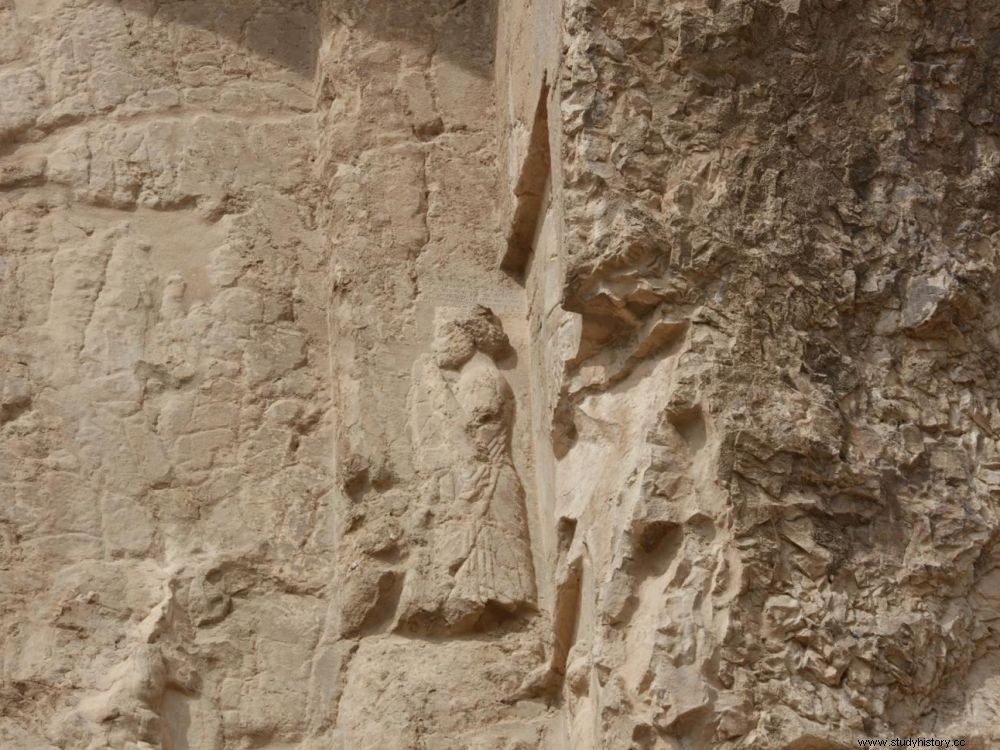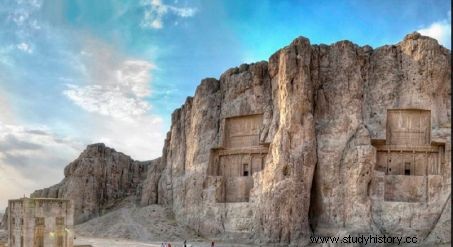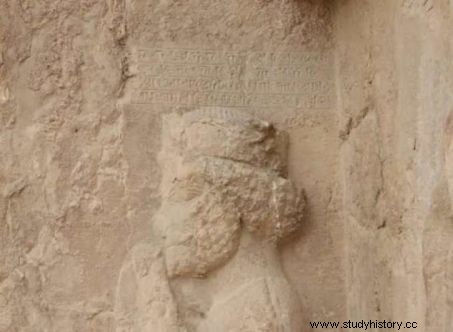An unpublished trilingual inscription from the Achaemenid period has just been discovered in Iran, near the tomb of Darius, king of the Persians.

The Achaemenid inscription had remained hidden for more than two millennia under lichens.
These are four lines of text, finely incised in the rock, which appeared to the eyes of specialists more than 2000 years after being engraved. Dating back to ancient Persia, these writings were spotted on a cliff sheltering the royal necropolis of Nasqh-e-Rostam, in the province of Fars, northwest of Persepolis (Iran). They date from the Achaemenid period, as this vast empire which stretched from the Iranian plateau to India is called, between 550 and 330 BC, famous for its rock tombs and its sets of engraved cuneiform inscriptions. . Calligraphies that had attracted the attention of scholars as early as the 19th century because they were written simultaneously - like a precious Rosetta Stone - in Old Persian, Elamite and Babylonian.

The royal necropolis of Naqsh-e Rostam, northwest of Persepolis, Iran. ©IRNA
These hitherto unknown lines were spotted by Motjaba Doroodi, a specialist in ancient Iranian languages and cultures. "At my request, this researcher had gone there with a photographer because I needed additional documents on Nasqh-e-Rostam, explains Soheil Delshad of the Institute of Iranian Studies at the Frei Universitat Berlin (Germany), joined in Iran by Sciences et Avenir. And it was while exploring the surroundings of the royal tomb of Darius that he suddenly saw these writings in the upper right corner of a bas-relief" . Although actually cleared in 2001 during a cleaning of the walls to remove the lichens and dust attacking the cliff, no one had ever documented this trilingual cuneiform inscription:the first two lines are in Old Persian, the third in Elamite and the fourth in Babylonian. They are just above a figure sculpted to the right of the royal tomb of Darius I, one of the greatest kings of the Persian Achaemenid Empire.
These are four lines of text, finely incised in the rock, which appeared to the eyes of specialists more than 2000 years after being engraved. Dating back to ancient Persia, these writings were spotted on a cliff sheltering the royal necropolis of Nasqh-e-Rostam, in the province of Fars, northwest of Persepolis (Iran). A site of the Achaemenid period, as this vast empire that stretched from the Iranian plateau to India, between 550 and 330 BCE is known, famous for its rock burials and sets of engraved cuneiform inscriptions. Calligraphies that had attracted the attention of scholars as early as the 19 th century because written simultaneously - like a precious Rosetta Stone - in Old Persian, Elamite and Babylonian.

The royal necropolis of Naqsh-e Rostam, northwest of Persepolis, Iran. ©IRNA
These hitherto unknown lines were spotted by Motjaba Doroodi, a specialist in ancient Iranian languages and cultures. "At my request, this researcher had gone there with a photographer because I needed additional documents on Nasqh-e-Rostam, explains Soheil Delshad of the Institute of Iranian Studies at the Frei Universitat Berlin (Germany), joined in Iran by Sciences et Avenir. And it was while exploring the surroundings of the royal tomb of Darius that he suddenly saw these writings in the upper right corner of a bas-relief" . Although actually cleared in 2001 during a cleaning of the walls to remove the lichens and dust attacking the cliff, no one had ever documented this trilingual cuneiform inscription:the first two lines are in Old Persian, the third in Elamite and the fourth in Babylonian. They are located just above a figure carved to the right of the royal tomb of Darius 1 st , one of the greatest kings of the Persian Achaemenid Empire.

Unknown inscriptions in Old Persian, Elamite and Babylonian. © M.A. Mosllanezhad
"The beginning of the inscription, which gives the character's name, suffers severe erosion damage “, continues Soheil Delshad. It is therefore impossible to identify it. The last part of his title, however, seems to be "Patishorian" , translated "pātišuvariš " in Old Persian and "Πατεισχορεῖς " in Greek. "The difficulty of the inscription comes mainly from the use of an unknown verb in the three languages ", says Soheil Delshad, its use not being attested in any of the Achaemenid Royal Inscriptions known to date. The four lines could however read as follows:"[Name (which is lost)], the Patishorian, (which ) "do something" for/Darius the King. The gesture of the character bringing his left hand to his mouth would have several interpretations. For some, it would be a sign of mourning while for others, it would be a mark of respect for the sovereign.
This discovery is considered exceptional in the field of Iranian studies. According to Wouter Henkelman, lecturer at the Ecole Pratique des Hautes Etudes (EPHE) in Paris, with whom Soheil Delshad works, "it adds a new verb to the three ancient languages in which it is transcribed! ". A scientific publication should follow shortly.
